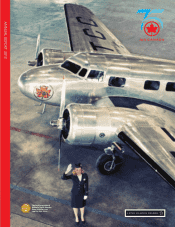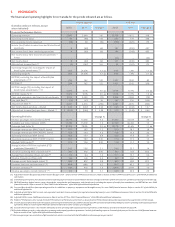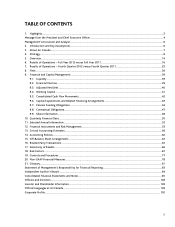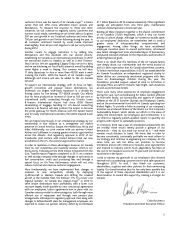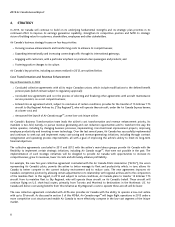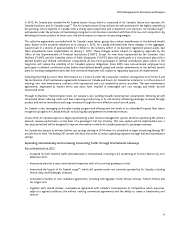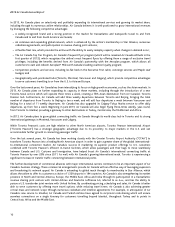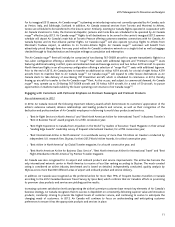Air Canada 2012 Annual Report Download - page 10
Download and view the complete annual report
Please find page 10 of the 2012 Air Canada annual report below. You can navigate through the pages in the report by either clicking on the pages listed below, or by using the keyword search tool below to find specific information within the annual report.2012 Air Canada Annual Report
10
In 2013, Air Canada plans on selectively and profitably expanding its international services and growing its market share,
including through its numerous airline relationships. Air Canada believes it is well-positioned to grow international revenues
by leveraging the following competitive advantages:
A widely-recognized brand and a strong position in the market for transatlantic and transpacific travel to and from
Canada and to and from South America via Canada;
An extensive and expanding global network, which is enhanced by the airline’s membership in Star Alliance, numerous
codeshare agreements, and participation in revenue sharing joint ventures;
A flexible fleet mix, which provides the airline with the ability to easily redeploy capacity when changes in demand occur;
The Air Canada Top Tier Program, Air Canada’s frequent flyer program (which will be renamed Air Canada Altitude in the
first quarter of 2013), which recognizes the airline's most frequent flyers by offering them a range of exclusive travel
privileges, including the benefits derived from Air Canada's partnership with the Aeroplan program, which allows all
customers to earn and redeem Aeroplan® Miles with Canada's leading coalition loyalty program;
Competitive products and services, including lie-flat beds in the Executive First cabin, concierge services and Maple Leaf
lounges; and
Geographically well-positioned hubs (Toronto, Montreal, Vancouver and Calgary), which provide competitive advantages
to serve customers travelling to or from the U.S. to Asia and Europe.
Over the last several years, Air Canada has been intensifying its focus on high growth economies, such as the Asian markets. In
2013, Air Canada plans on further expanding its capacity in these markets, including through the introduction of a new
Toronto-Seoul service which will operate three times a week, creating a fifth Asian destination from Air Canada's Toronto
Pearson hub. Furthermore, Air Canada will add three weekly departures between Toronto and Beijing, bringing the total
number of departures from Toronto to Beijing to ten a week, and will add four departures a week between Vancouver and
Beijing, for a total of 11 weekly departures. Air Canada has also upgraded its Calgary-Tokyo Narita service to offer daily
departures, up from five a week. Beginning in June 2013, Air Canada will also begin flying three-times weekly, year-round,
from Toronto to Istanbul, providing a gateway to other destinations in Turkey, Central Asia, the Middle East and Africa.
In 2013, Air Canada plans to grow global connecting traffic via Canada through its world-class hub in Toronto and its strong
international gateways in Montreal, Vancouver and Calgary.
While Toronto Pearson’s costs are high relative to other North American airports, Toronto Pearson International Airport
(“Toronto Pearson”) has a strategic geographic advantage due to its proximity to major markets in the U.S. and can
accommodate further growth in connecting passenger traffic.
Over the last several years, Air Canada has been working closely with the Greater Toronto Airport Authority (“GTAA”) to
transform Toronto Pearson into a leading North American airport in order to gain a greater share of the global international-
to-international connection market. Air Canada’s success in marketing its superior product offerings to U.S. customers
combined with Toronto Pearson’s efficient in-transit facilities, which allow passengers and their bags to move seamlessly
between Canada and U.S. Customs and Immigration, have helped boost Air Canada’s international connecting traffic at
Toronto Pearson by over 20% since 2011. As well, with Air Canada's growing International reach, Toronto is experiencing a
significant increase in transfer traffic connecting between international points.
The further development of commercial alliances with major international carriers continues to be an important aspect of Air
Canada’s business strategy. These commercial arrangements provide Air Canada with an effective way of leveraging expansion
and broadening its network appeal. Air Canada is extending its global reach through its membership in Star Alliance, which
allows the airline to offer its customers a choice of 1,329 airports in 194 countries. Air Canada is also strengthening its market
presence in North and Central America, Europe, the Middle East, Africa and India through its participation in a transatlantic
revenue sharing joint venture with United Airlines and Deutsche Lufthansa AG, referred to as A++, and has the ability to
pursue a U.S. transborder joint venture with United Airlines. By coordinating pricing, scheduling and sales, Air Canada is better
able to serve customers by offering more travel options, while reducing travel times. Air Canada is also achieving greater
critical mass and network scope through numerous codeshare and interline agreements. For example, in anticipation of Air
Canada’s new service to Istanbul, Air Canada and Turkish Airlines have agreed to reciprocal code-sharing which will ensure
seamless connections on a single itinerary for customers travelling beyond Istanbul, throughout Turkey and to points in
Central Asia, Africa and the Middle East.

